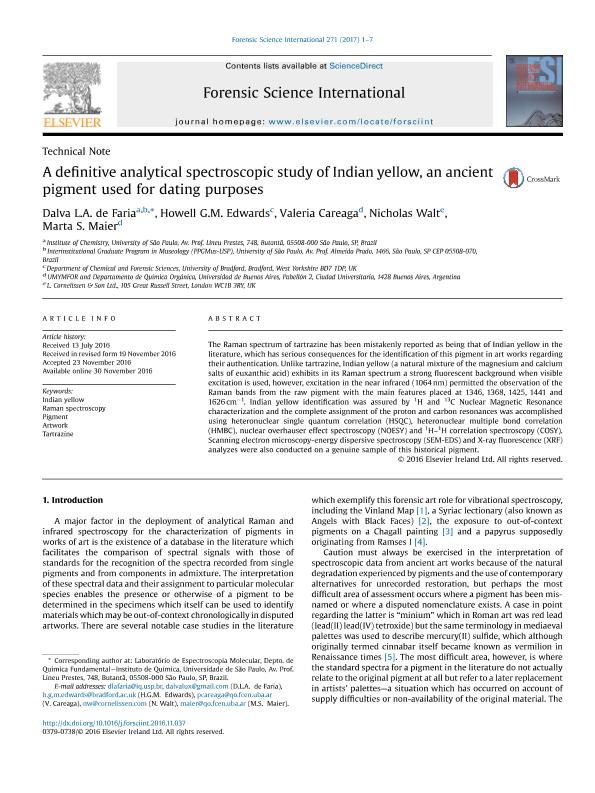Mostrar el registro sencillo del ítem
dc.contributor.author
de Faria, Dalva L.A.
dc.contributor.author
Edwards, Howell G. M.

dc.contributor.author
Careaga Quiroga, Valeria Pilar

dc.contributor.author
Walt, Nicholas
dc.contributor.author
Maier, Marta Silvia

dc.date.available
2018-09-05T14:50:52Z
dc.date.issued
2017-02
dc.identifier.citation
de Faria, Dalva L.A.; Edwards, Howell G. M.; Careaga Quiroga, Valeria Pilar; Walt, Nicholas; Maier, Marta Silvia; A definitive analytical spectroscopic study of Indian yellow, an ancient pigment used for dating purposes; Elsevier Ireland; Forensic Science International; 271; 2-2017; 1-7
dc.identifier.issn
0379-0738
dc.identifier.uri
http://hdl.handle.net/11336/58356
dc.description.abstract
The Raman spectrum of tartrazine has been mistakenly reported as being that of Indian yellow in the literature, which has serious consequences for the identification of this pigment in art works regarding their authentication. Unlike tartrazine, Indian yellow (a natural mixture of the magnesium and calcium salts of euxanthic acid) exhibits in its Raman spectrum a strong fluorescent background when visible excitation is used, however, excitation in the near infrared (1064 nm) permitted the observation of the Raman bands from the raw pigment with the main features placed at 1346, 1368, 1425, 1441 and 1626 cm−1. Indian yellow identification was assured by 1H and 13C Nuclear Magnetic Resonance characterization and the complete assignment of the proton and carbon resonances was accomplished using heteronuclear single quantum correlation (HSQC), heteronuclear multiple bond correlation (HMBC), nuclear overhauser effect spectroscopy (NOESY) and 1H–1H correlation spectroscopy (COSY). Scanning electron microscopy-energy dispersive spectroscopy (SEM-EDS) and X-ray fluorescence (XRF) analyzes were also conducted on a genuine sample of this historical pigment.
dc.format
application/pdf
dc.language.iso
eng
dc.publisher
Elsevier Ireland

dc.rights
info:eu-repo/semantics/openAccess
dc.rights.uri
https://creativecommons.org/licenses/by-nc-sa/2.5/ar/
dc.subject
Artwork
dc.subject
Indian Yellow
dc.subject
Pigment
dc.subject
Raman Spectroscopy
dc.subject
Tartrazine
dc.subject.classification
Otras Ciencias Químicas

dc.subject.classification
Ciencias Químicas

dc.subject.classification
CIENCIAS NATURALES Y EXACTAS

dc.title
A definitive analytical spectroscopic study of Indian yellow, an ancient pigment used for dating purposes
dc.type
info:eu-repo/semantics/article
dc.type
info:ar-repo/semantics/artículo
dc.type
info:eu-repo/semantics/publishedVersion
dc.date.updated
2018-09-04T19:00:53Z
dc.identifier.eissn
1872-6283
dc.journal.volume
271
dc.journal.pagination
1-7
dc.journal.pais
Irlanda

dc.journal.ciudad
Limerick
dc.description.fil
Fil: de Faria, Dalva L.A.. Universidade de Sao Paulo; Brasil
dc.description.fil
Fil: Edwards, Howell G. M.. University of Bradford; Reino Unido
dc.description.fil
Fil: Careaga Quiroga, Valeria Pilar. Consejo Nacional de Investigaciones Científicas y Técnicas. Oficina de Coordinación Administrativa Ciudad Universitaria. Unidad de Microanálisis y Métodos Físicos en Química Orgánica. Universidad de Buenos Aires. Facultad de Ciencias Exactas y Naturales. Unidad de Microanálisis y Métodos Físicos en Química Orgánica; Argentina
dc.description.fil
Fil: Walt, Nicholas. L. Cornelissen & Son; Reino Unido
dc.description.fil
Fil: Maier, Marta Silvia. Consejo Nacional de Investigaciones Científicas y Técnicas. Oficina de Coordinación Administrativa Ciudad Universitaria. Unidad de Microanálisis y Métodos Físicos en Química Orgánica. Universidad de Buenos Aires. Facultad de Ciencias Exactas y Naturales. Unidad de Microanálisis y Métodos Físicos en Química Orgánica; Argentina
dc.journal.title
Forensic Science International

dc.relation.alternativeid
info:eu-repo/semantics/altIdentifier/url/https://linkinghub.elsevier.com/retrieve/pii/S0379-0738(16)30522-9
dc.relation.alternativeid
info:eu-repo/semantics/altIdentifier/doi/http://dx.doi.org/10.1016/j.forsciint.2016.11.037
Archivos asociados
